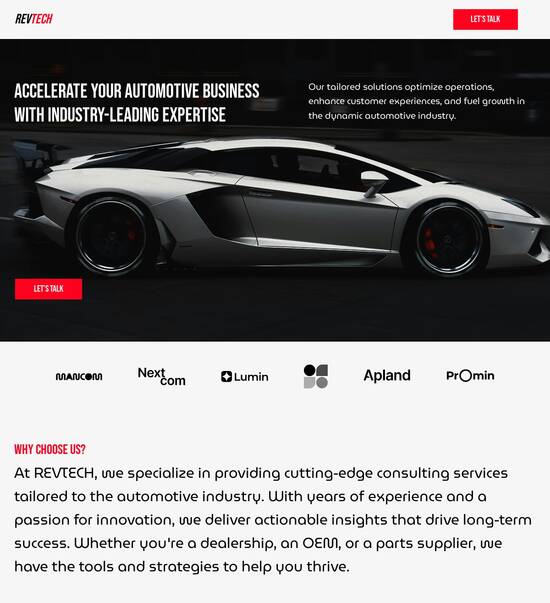
HTML/CSS optimized commission page template
Explore Similar TemplatesAbout template
Supercharge your commission page with HTML/CSS for outstanding performance! Learn more today.
Recommended templates

Easy to build without coding
With the intuitive drag-and-drop builder, anyone on your team can create high-converting pages without any knowledge of code or design. Make enhancements to your landing page with custom widgets using Javascript, HTML/CSS, or third-party scripts.

Multiple layouts for any industry and goal
Select from 500+ landing page layouts built to boost conversions across industry-specific scenarios. Customize them by adjusting fonts, adding images, and generating on-brand content with the AI assistant. Quickly scale with Instablocks® and Global Blocks that you can save, reuse, and update globally.

Loads fast and looks polished on any device
Every template is responsive, which means they present professionally on any device and load blazingly fast with our Thor Render Engine. You can also power them up with Google AMP technology to deliver an unparalleled mobile experience and drive higher conversions.

Robust analytics & experimentation
Get real-time updates and reporting across all your devices, showing the number of visitors, conversions, cost-per-visitor, and cost-per-lead. Launch AI-powered experiments, run A/B tests, and use heatmaps to analyze user behavior, then optimize your landing page to maximize conversions.







Easy to build without coding
With the intuitive drag-and-drop builder, anyone on your team can create high-converting pages without any knowledge of code or design. Make enhancements to your landing page with custom widgets using Javascript, HTML/CSS, or third-party scripts.
Multiple layouts for any industry and goal
Select from 500+ landing page layouts built to boost conversions across industry-specific scenarios. Customize them by adjusting fonts, adding images, and generating on-brand content with the AI assistant. Quickly scale with Instablocks® and Global Blocks that you can save, reuse, and update globally.
Loads fast and looks polished on any device
Every template is responsive, which means they present professionally on any device and load blazingly fast with our Thor Render Engine.
Robust analytics & experimentation
Get real-time updates and reporting across all your devices, showing the number of visitors, conversions, cost-per-visitor, and cost-per-lead. Launch AI-powered experiments, run A/B tests, and use heatmaps to analyze user behavior, then optimize your landing page to maximize conversions.
All the features you need to build lead-generating landing pages
Explore more featuresLearn how to build top-performing landing pages for any goal
FAQs
Leading the way in building high-performing landing pages





Maximizing ROI with Instapage: The Ultimate Guide to Landing Page Optimization
In the fast-paced digital marketing landscape, a powerful landing page can be the difference between a lead and a lost opportunity. Instapage provides the most robust tools in the industry for marketers aiming to boost conversions and streamline their workflow. This guide will walk you through the step-by-step process of creating high-converting landing pages that not only attract visitors but also maximize return on investment (ROI).
Understanding the Power of Landing Pages
Landing pages serve as the first point of contact for potential customers. With Instapage’s extensive library of over 100 ready-to-use templates and essential lead generation elements, creating an effective landing page has never been easier. Here’s why these pages are crucial:
- Capture Leads Quickly: Using pre-defined elements lets you leverage tried-and-tested designs for maximum engagement.
- Easy Customization: Alter layouts and designs within minutes without needing a developer’s assistance.
- Track Performance: Instapage provides an analytics dashboard that lets marketers assess and optimize their campaigns in real time.
Step 1: Choosing the Right Template
Start by selecting one of Instapage's high-converting templates that align with your marketing goals. Personalization is key, so choose a design that resonates with your target audience. Consider these factors as you choose:
- Audience Relevance: Select templates that speak directly to the verticals you’re targeting, whether it’s education or tech.
- Simplicity Over Complexity: Templates that are clean and focused yield higher conversion rates.
- Mobile Optimization: Ensure that your template is responsive to cater to users on mobile devices.
Step 2: Crafting Compelling Content
After selecting a template, focus on the content you will place on your pages. Quality content can drive conversions, so here are some tips:
- Clear Call-to-Actions: Use action-oriented phrases like 'Get Started Now' or 'Join Our Webinar' to lead users.
- Benefit-Focused Messaging: Clearly articulate how your service solves problems or enhances performance.
- Visual Elements: Include relevant images, icons, and videos that engage users while complementing your message.
Step 3: Optimize and Experiment
Once your landing page is live, the work doesn’t stop. Regularly optimize it using Instapage’s built-in A/B testing tools and heatmaps to understand user behavior.
- Run A/B Tests: Experiment with different headlines, CTAs, and images to find which combination performs best.
- Analyze Heatmaps: Use heatmap data to observe where users are clicking and scrolling.
- Keep an Eye on Analytics: Use the dashboard to track conversions, bounce rates, and other vital metrics to continually refine your strategy.
In conclusion, leveraging Instapage for creating bespoke landing pages equips marketers with the tools to optimize efforts effectively, ensuring every campaign hits its mark.
Ready to elevate your digital marketing campaigns with Instapage? Start your free trial today and transform how you manage your landing pages!
People also ask about HTML/CSS optimized commission page template
HTMLCSS optimized commission page template: A comprehensive guide
Understanding the role of HTML and CSS in optimized commission page templates
HTML (Hypertext Markup Language) and CSS (Cascading Style Sheets) serve as the backbone of web design and development. These technologies are crucial in creating optimized commission page templates that guide potential customers towards making purchases. While HTML structures the content on the page—organizing headers, paragraphs, images, and links—CSS enhances the visual appeal, making the pages not only functional but also aesthetically pleasing.
Using clean, efficient code is vital for the performance of these templates. Excessive coding can lead to slower loading times, disrupting user experience and potentially decreasing conversion rates. Therefore, understanding how to effectively integrate HTML and CSS is essential for marketers looking to create impactful commission pages.
The foundation of web design: HTML and CSS integration
When creating commission page templates, the seamless integration of HTML and CSS is where the magic happens. HTML provides the necessary structure, while CSS styles that structure to resonate with potential customers. A well-defined hierarchy of elements—from headings to product descriptions—allows users to navigate the information with ease.
Clean HTML code increases loading speed, enhancing user experience.
CSS enables customization options, allowing brands to maintain their unique style.
Responsive design is achieved through CSS, ensuring a consistent experience across devices.
Key elements of an effective commission page template
An effective commission page template includes vital elements that can significantly influence conversion rates. To start, your headline and sub-headline should be attention-grabbing, clearly stating the purpose of the page and the offers available. Product descriptions need to not only inform but also persuade, highlighting key benefits and addressing potential customer pain points.
Incorporating call-to-action buttons is essential; they guide users towards making a purchase or signing up for a service. Images and videos should be eye-catching yet relevant, as compelling visuals can enhance engagement significantly. Additionally, user testimonials and reviews add credibility, instilling trust in your offerings.
Layout considerations for enhanced user experience
When selecting a layout for your commission page, consider the impact of both single-column and multi-column designs. Single-column layouts are generally easier to navigate, while multi-column layouts can display more information at once. However, finding the right balance is essential; too much information in a crowded space can overwhelm visitors, leading to disengagement.
Whitespace is equally important to focus user attention on critical content and call-to-action buttons. Responsive design must also be prioritized, ensuring that your commission page looks great on desktops, tablets, and mobile devices. A/B testing various layouts can provide you with invaluable insights on what resonates best with your target audience.
Features unique to an affiliate marketing template
For affiliate marketing, certain features are particularly beneficial in driving conversions. Customizable templates allow marketers to tailor designs to specific audiences or products. It's also beneficial to incorporate affiliate links and tracking codes subtly within the content, ensuring a smooth user experience while also collecting valuable metrics.
Additionally, incorporating dynamic content can personalize user experiences and boost engagement. By providing personalized recommendations based on user behavior or demographics, you can capture user interest more effectively, leading to potentially increased conversion rates.
Leveraging CSS for impactful design elements
CSS can significantly affect the design elements of a commission page. Stylish buttons, for instance, not only improve functionality but also attract user attention to essential actions. Using CSS animations can further enhance user experience by directing users' focus to vital areas, such as current promotions or discounts.
Ensuring brand consistency through appropriate color schemes and font choices is also a must. This creates a cohesive appearance across all your marketing channels, bolstering brand recognition over time.
Optimizing for affiliate products: strategies and techniques
When promoting affiliate products, crafting compelling messaging is key. Begin by identifying the primary benefits of the products and how they address users' needs. Utilize bullet points for clarity, allowing users to quickly grasp the advantages offered.
Highlighting customer testimonials can also provide both social proof and reassurance, encouraging potential buyers to commit. Finally, analyze case studies of successful brands; understanding their strategies can offer inspiration on how to best market your affiliate products.
Understanding and overcoming design challenges
Designing commission pages comes with its own set of challenges. Common pitfalls, such as overcrowded layouts and unclear messaging, can lead to confusion or frustration among users. To mitigate these challenges, focus on clear navigation and concise content to streamline the user's journey.
Slow loading times due to heavy media usage can also hinder user engagement. Optimizing images and media files for the web can help maintain a high quality without sacrificing speed. Ultimately, prioritizing user experience should be at the forefront of your design process.
Enhancing messaging features for stronger engagement
Persuasive copywriting plays a crucial role in user engagement on commission pages. Utilizing storytelling techniques can create an emotional connection and desire in potential customers; stories related to the product can enhance relatability. Additionally, integrating chatbots and live support services can provide users with immediate assistance, further enhancing customer satisfaction.
Clear calls to action within your messaging can also guide users towards making a decision, increasing the likelihood of conversions.
Collaborating for success: involving stakeholders in the design process
Involving various stakeholders in the design process—marketers, developers, and designers—can lead to more well-rounded commission pages. Gathering feedback from potential users helps to inform design choices, ensuring that the final product resonates with the target audience.
The iterative process of prototyping and refining based on user input is crucial. It allows for continuous improvement of the design, ultimately creating a more effective conversion tool.
Understanding affiliate payout structures
Familiarizing yourself with various affiliate payout structures—such as Cost Per Action (CPA), Cost Per Lead (CPL), and revenue sharing—is essential for enhancing your commission page templates. These elements can influence how users perceive value, ultimately impacting their level of commitment.
Incorporating clear information about payout benefits can further encourage potential affiliates to engage, offering them insight into what they could gain from promoting your products.
Strategies for elevating affiliate campaigns with design
Elevating your affiliate campaigns through design involves aligning the visual elements with broader marketing strategies. Utilizing tools and plugins specifically designed for affiliate marketing can enhance designs and integrate useful functions, such as performance tracking and image optimization.
Continual improvement is vital as well. Regularly reviewing and refining templates based on performance metrics ensures your commission page remains effective and relevant.
The future of commission page templates in digital marketing
Looking ahead, emerging trends in web design will significantly influence commission page templates. As user preferences evolve, the role of HTML and CSS in creating intuitive, responsive designs will become even more crucial. Optimizing user experience should remain a central focus, as it's this experience that will ultimately dictate the success or failure of conversion strategies.
By adopting best practices in HTML and CSS, marketers can stay ahead of competitors and align their pages with changing market demands.
Practical steps to create your own optimized commission page template
Creating your own optimized commission page template involves several practical steps. Start with defining the purpose of your page and the products you wish to promote. Utilize content management tools like Instapage, which offers a library of conversion-focused layouts, to streamline your design process.
Ensure that your design is clean, responsive, and optimized for speed. Leverage insights gained from A/B testing to refine elements further and create a user-friendly experience. Remember, continuous optimization and implementing feedback are critical for maintaining relevance in affiliate marketing.
Ready to skyrocket conversions?
Supercharge your ad campaigns with high-performing landing pages
Get started














